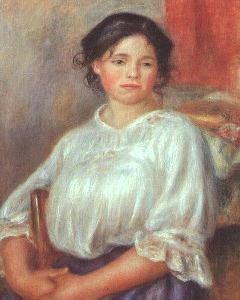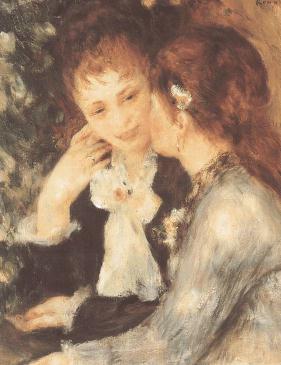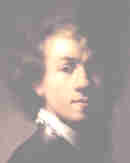^
Died on 22 December 1915: Arthur Hughes,
English Pre-Raphaelite painter born on 27 January 1832.
— Pre-Raphaelite painter and illustrator. Studied under Alfred Stevens.
In about 1850 he converted to Pre-Raphaelitism. Met Holman Hunt, Rossetti,
Madox Brown, and later Millais. In 1852 he exhibited his first major Pre-Raphaelite
picture Ophelia. Throughout the 1850s and 1860s Hughes continued
to produce a series of delicately poetic pictures, which hover on the knife-edge
between sentiment and sentimentality but are always redeemed by their brilliant
color and microscopic detail. Some of the best known are Home from the
Sea, The Long Engagement, Aurora Leigh's Dismissal of Romney and April
Love which Ruskin thought "exquisite in every way". In 1857 he worked
with other Pre-Raphaelites on the frescoes in the Oxford Union. About 1858,
Hughes retired to live with his family in the suburbs of London. He lived
at 284 London Rd, Wallington, Sutton, and at Eastside House, 22 Kew Green,
Richmond. Hughes being of a quiet and retiring nature, very little is known
of his later career. After about 1870 his work lost its impetus. Hughes
was the original illustrator of Tom Brown's Schooldays, and George
MacDonald's At the Back of the North Wind and The Princess and
the Goblin. He also illustrated Allingham's Music Master and
many other novels, children's books and periodicals. He worked with Christina
Rossetti on Sing Song in 1871. He died on 22 December 1915. A sale of his
works took place at Christie's after his death on 21 November 1921. . —
Arthur
Hughes and his daughter Agnes, photographed by Lewis Carroll. —
Drawing
portrait by the artist's son, Arthur Foord Hughes)
— LINKS
— Self-Portrait
(1851)
— Ophelia
(1853; 68x124cm) _ The writing on the frame of this painting reads: 'There
is a willow grows aslant the brook, That shows his hoar leaves in the glassy
stream; There with fantastic garlands did she come. Of crow-flowers, nettles,
daisies, and long purples. There on the pendant boughs her coronet weeds
Clambering to hang an envious sliver broke. When down the weedy trophies
and herself Fell in the weeping brook.' Buy print from art.com Buy print
from AllPosters Buy print from Easyart (UK)
— Home
From the Sea (1857, 51x65cm) _ A sailor boy has come back from the sea
to find that his mother has died. With his sister he is mourning at her
grave. Hughes began the picture in 1856, in the old churchyard at Chingford
in Essex. At first the picture contained only the figure of the boy, and
was entitled A Mother's Grave; later the sister was added, and the
title was changed. The model for the boy may have been Hughes' nephew, Edward
Robert Hughes.
— Knight
of the Sun (1861, 22x32cm) _ An aged warrior mortally wounded, being
carried by his men-at-arms to the shelter of a religious house.
— La
Belle Dame Sans Merci (1863, 152x122cm) _ This painting is based on
La
Belle Dame Sans Merci by John Keats _ See another painting on the
same subject: La
Belle Dame Sans Merci (by Cowper)
_
— Ophelia
and He Will Not Come Again (1864, 95x60cm) _ described this painting
as Ophelia 'approaching the water and looking back at us, singing her last
song.' Inscribed on the back is the following verse: 'Ophelia (sings) And
will he not come again? And will he not come again? No, no he is dead Go
to thy death-bed He never will come again. His beard was as white as snow,
All flaxen was his poll: He is gone, he is gone, And we cast away moan;
Gramercy on his soul! And of all Christian souls, I pray God - God be wi'
you. Exit'.
— A
Music Party (1864) _ When exhibited at the Royal Academy in 1864, the
accompanying lines from John Keats' Ode on a Grecian Urn were included
in the catalogue: 'Heard melodies are sweet, but those unheard are sweeter
Not to the sensual ear, but more endear'd Pipe to the spirit ditties of
no tone.'
— Good
Night (1866, 99x65cm) _ 'Day's turn is over: now arrives the Night's.'
from Robert Browning, Pippa Passes.
— Sir
Galahad (1869, 113x168cm) _ Inscribed on the back: 'The clouds are broken
in the sky, And thro' the mountain-walls, A rolling organ-harmony Swells
up, and shakes and falls, Then move the trees, the copses nod, Wings flutter,
voices hover clear: Oh just and faithful knight of God! Ride on: the prize
is near. So pass I hostel, hall, and grange; By bridge and ford, by park
and pale, All-arm'd I ride, whate'er betide, Until I find the holy Grail'.
.... A gentle sound, an awful sight! Three angels bear the holy grail: With
folded feet, in stoles of white, On sleeping wings they sail.'
— Endymion
(1870, 76x106cm) _ 'Brain-sick shepherd prince, What promise hast thou faithful
guarded since The day of sacrifice? or have new sorrows Come with the constant
dawn upon thy morrows? Alas! 't is his old grief. For many days Has he been
wandering in uncertain ways, Through wilderness and woods of mossed oaks'
— The
Heavenly Stair (1888, 178x88cm) _ ‘Little one who straight has
come down the heavenly stair. Our birth is but a sleep and a forgetting:
The Soul that rises with us, our life's Star, Hath had elsewhere its setting,
And cometh from afar: Not in entire forgetfulness, And not in utter nakedness,
But trailing clouds of glory do we come From God, who is our home.’
— Wonderland
(1912) —
The Annunciation (1858) — The
Nativity (1858) — The
Mower (1865) |

 ^
2000 One Rembrand and 2 Renoirs stolen.
^
2000 One Rembrand and 2 Renoirs stolen. [< the
one shown here is safe at the Mauritshuis in The Hague] and two works
by the French impressionist Pierre-Auguste
Renoir — A Young Parisian Woman and Conversation [not those
shown here: Young Women talking 1878 >, and < Young
Girl Seated 1909].
[< the
one shown here is safe at the Mauritshuis in The Hague] and two works
by the French impressionist Pierre-Auguste
Renoir — A Young Parisian Woman and Conversation [not those
shown here: Young Women talking 1878 >, and < Young
Girl Seated 1909].